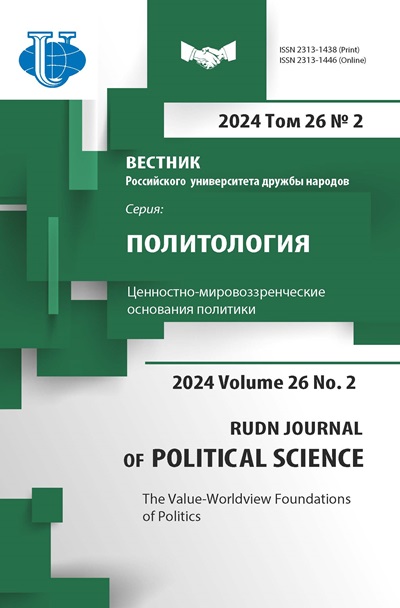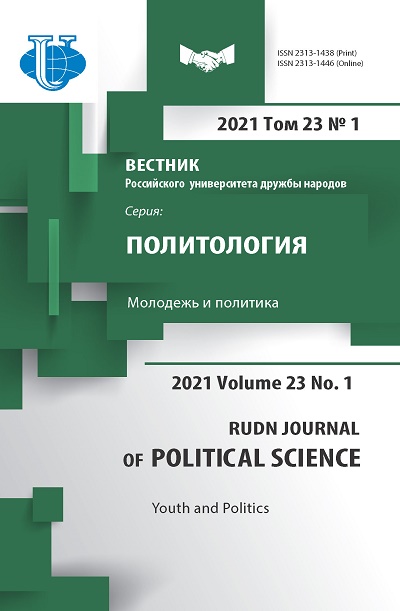Key Identity Features of Urban Youth: The Case of Krasnodar Krai
- Authors: Samarkina I.V.1, Bashmakov I.S.1
-
Affiliations:
- Kuban State University
- Issue: Vol 23, No 1 (2021): Youth and Politics
- Pages: 159-171
- Section: YOUTH IN POLITICS: A REGIONAL DIMENSION
- URL: https://journals.rudn.ru/political-science/article/view/25718
- DOI: https://doi.org/10.22363/2313-1438-2021-23-1-159-171
Cite item
Full Text
Abstract
This article is devoted to the study of urban youth local identity in a large and medium city. This identity is manifested in everyday interaction with the urban community, its socio-political institutions and visitors and affect the level of public and political participation, the presence of constructive civic practices. The aim is to identify and describe the main components and place of local youth identity in the system of social identities in large and medium-sized cities of Krasnodar krai (Krasnodar, Novorossiysk, Sochi and Armavir). The empirical basis of the study was made up of focus group transcripts conducted with various groups of young people (schoolchildren, students, and working youth). To verify the conceptual model a modified version of the Kuhn-McPartland method was used. On the basis of the conducted empirical research, the place of local identity in the system of urban youth social and territorial identities was revealed. The dependence between the size of a city and a cohort of young people and a local identity was shown. Such components of young people local identity as awareness of the city and its socio-political life, attitude towards representatives of other communities, a sense of their involvement in city life, the desire to stay and live in the city, the will to work for the benefit of the city, to participate in its socio-political life. The study made it possible to identify the valence of youth identity (negative, neutral, positive). The trajectories of young people spatial mobility that affect the degree of actualization and valence of local identity were also described. The dependence between the strength of youth local identity and participation in public and political activity for the benefit of the city and the region, participation in the activities of public and political organizations has been revealed.
About the authors
Irina Vladimirovna Samarkina
Kuban State University
Author for correspondence.
Email: smrkn@mail.ru
Doctor of Political Science, Associate Professor, Head of Management and Psychology Faculty, professor of Public policy and Public management Department
Krasnodar, Russian FederationIgor Stanislavovich Bashmakov
Kuban State University
Email: igorbash87@mail.ru
PhD in Political Science, Associate Professor of Public Policy and Public Management Department
Krasnodar, Russian FederationReferences
- Bass, O., & Houghton, J. (2018). Street names and statues: The identity politics of naming and public art in contemporary durban. Urban Forum, 29(4): 413.
- Bauder, H. (2016). Possibilities of urban belonging. Antipode, 48: 252–271. doi: 10.1111/ANTI.12174
- Bessière, J. (1998). Local development and heritage: Traditional food and cuisine as tourist attractions in rural areas. Sociologia Ruralis, 38(1): 21–34.
- Bonaiuto, M., Aiello, A., Perugini, M., Bonnes, M., & Ercolani, M. P. (1999). Multidimensional perception of residential environment quality and neighbourhood attachment in the urban environment. Journal of Environmental Psychology, 19: 331–352.
- Diaghileva, N. S. (2013). Theoretical aspects of urban identity. In A. M. Britvin (Ed.), Branding of Small and Mediumsized Cities in Russia: Experience, Problems, Prospects. Yekaterinburg: UrfU (рр. 54–59). (In Russian).
- DiGregorio, M. (2007). Things held in common: Memory, space and the reconstitution of community life. Journal of Southeast Asian Studies, 38: 441–465. doi: 10.1017/s0022463407000215
- Dovbysh, E. G. (2012). Network technologies of shaping urban identity. Human. Community. Management, 4: 111–118. (In Russian).
- Evseenkova, E. O. (2014). The modality of urban identity. Bulletin of the Perm Federal Research Centre Journal, 5: 80–86. (In Russian).
- Evstifeev, R. V. (2017). Research of local identities: Theoretical approaches and perspective directions. Research Result. Sociology and Management, 2: 3–9. doi: 10.18413/2408-9338-2017-3-2-3-9. (In Russian).
- Fedotova, N. (2017). The formation of urban identity: Factorial and institutional aspects. The Journal of Sociology and Social Anthropology, 20(3): 32–49. (In Russian).
- Gornova, G. (2018). Harmony between the city and the man: Problems of forming city identity. PRAXEMA. Journal of Visual Semiotics, 3(17): 43–56. doi: 10.23951/2312-7899-2018-3-43-56. (In Russian).
- Keogan, K. (2002). A sense of place: The politics of immigration and the symbolic construction of identity in Southern California and the New York Metropolitan area. Sociological Forum, 17(2): 223–253. doi: 10.2307/3070325
- Lynch, K. (1960). The Image of the City. Cambridge: MIT Press. 208 p.
- Morozova, E. V., & Ulko, E. V. (2008). Local identity: Forms of actualization and types. Political expertise: POLITEX, 4: 139–151. (In Russian).
- Muraveva, O. I., Litvina, S. A., Kruzhkova, O. V., & Bogomaz, S. A. (2017). Features of the structure of identity with the city of youth in Russian cities. Bulletin of the Novosibirsk State Pedagogical University, 1: 63–80. (In Russian).
- Nazukina, M. V. (2017). Local Identity. In I. S. Semenenko (Ed.), Identity: The Individual, Society, and Politics. An Encyclopedia. Moscow: Ves Mir Publ. (pp. 512–516). (In Russian).
- Nedoseka, E. V., & Anufrieva, T. V. (2015). Features of urban identity of youth in Murmansk. Sociology of the city, 3: 22–31. (In Russian).
- Nijman, J. (2007). Locals, exiles and cosmopolitans: a theoretical argument about identity and place in Miami. Tijdschrift voor economische en sociale geografie, 98: 176–187.
- Oktay, D. (2002). The quest for urban identity in the changing context of the city. Cities, 19(4): 261–271. DOI: 1016/S0264-2751(02)00023-9
- Okunev, I. Yu. (2018). Territorial and spatial identity: New approarch to the basic concepts. Comparative Politics Russia, 1: 18–25. doi: 10.24411/2221-3279-2018-00002. (In Russian).
- Rausch, A. S. (2005). Local identity, cultural commodities, and development in rural Japan: The potential as viewed by cultural producers and local residents. International Journal of Japanese Sociology, 14: 122–137. doi: 10.1111/j.1475-6781.2005.00073.x
- Samarkina, I. V. (2017). Subjective space of politics. In I. S. Semenenko (Ed.), Identity: The Individual, Society, and Politics. An Encyclopedia. Moscow: Ves Mir Publ. (рр. 380–385). (In Russian).
- Seamon, D., & Sowers, J. (2008). Place and placelessness, Edward Relph. In P. Hubbard, R. Kitchen & G. Vallentine (Eds.), Key Texts in Human Geography. London: Sage (pp. 43–51).
- Tuan, Y.-F. (1977). Space and Place: The Perspective of Experience. London: Edward Arnold. 235 p.
















